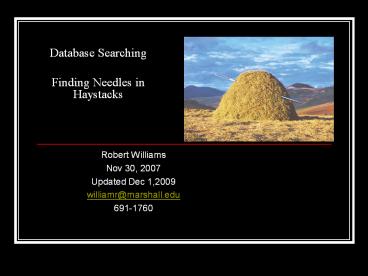Database Searching Finding Needles in Haystacks - PowerPoint PPT Presentation
1 / 19
Title:
Database Searching Finding Needles in Haystacks
Description:
Thesaurus. Web. MU. Web MU. Access. Publisher Sites. Publisher Sites. Web ... A thesaurus that facilitates precise retrieval of relevant citations from the ... – PowerPoint PPT presentation
Number of Views:265
Avg rating:3.0/5.0
Title: Database Searching Finding Needles in Haystacks
1
Database SearchingFinding Needles in
Haystacks
- Robert Williams
- Nov 30, 2007
- Updated Dec 1,2009
- williamr_at_marshall.edu
- 691-1760
2
Picking the Right Database
- What type of documents or resources are indexed?
- Disciplines Education, Psych, Medical
- Journal List
- Format types Journal Articles, Reports,
Conferences, books, Dissertations. - Scope International? Which Languages?
- Current or retrospective?
3
Databases Database Comparison
4
Database Comparison Part 2
5
PubMed/Medline from NLM (National Library of
Medicine)
- Introduction to Searching
- Robert Williams
6
What is PubMed?
- Bibliographic with Abstracts and Links to Full
Text - Comprehensive - Covers all Bio-Medical and
Clinical topics - 5,608 Journals Indexed
- 19 Million Citations
- International Indexes journals in 37 Languages
- Very Current Updated Daily Tuesdays through
Saturdays - Goes way back 1948 to Present
- Open to All Free from NLM
7
Whats the difference between PubMed and Medline?
- Medline is a database which is searched by using
many different public and commercial search
engines. - PubMed contains all of Medline, plus recently
added entries that are in process to add MESH
descriptors. - Also contains non-biomedical citations from
General Science Journals, Consumer Health
Articles - PubMed is both a database and a Web-based search
engine.
8
National Library of MedicineBiomedical Indexing
Timeline
- 1879 - 1st volume of Index Medicus Published
- 1964 - Medlars Automated database used to produce
Index Medicus - 1966 - Batch searching by specially trained
Librarians - 1971 - Medlars Online or Medline accessible
- 1986 - Grateful Med searched by Health care
Professionals - 1997 - PubMed on the Web
- 1998 MedlinePlus offers consumer info
- 2000 - Clinical Trials made Web searchable
9
What is MESH (Medical Subject Headings)?
- A thesaurus that facilitates precise retrieval of
relevant citations from the Medline and PubMed
Databases - http//www.nlm.nih.gov/mesh/MBrowser.html
- Automatic truncation (Fragments)
- Trained specialists apply unlimited headings to
citations. Headings can be weighted according
relevancy. - Trees, Scope Notes, Valid Sub Headings
10
PubMed Vs. Google
11
Subject Searching PubMed
- Use any term, Automatic Mapping
- Qualifiers
- Limit by Fields TI, MH, AB in brackets
- Subheadings /th /ci /ae /ep /sn /px /mo /bs
- Explosion is automatic unless you turn it off.
12
TOO Much
- Qualifiers
- Fields TI, MH, in brackets
- Major Heading mj
- Subheadings
- Limits
- Language
- Years
- Human
- Review
13
Advanced Search - History
- Go Here if you are lost
- Use to refer to statement numbers
- Combine statements using AND OR NOT Operators
- Use for AND for OR
- Display Statement Results
- Preview runs faster than Search
14
Verification Searching
- Starting with a Known citation
- Assume Errors
- Use Single Citation Search
- Any field can be searched
- Vol., Issue Number, Pages
- Important title words with Author
- Use Authors Last name and one initial
15
Displaying Results
- Number of Citations per page (20 default, 200
Max) - Format
- Summary (Regular and Text)
- Abstract (Regular and Text)
- Medline
- XML
- PMID List
- Sort
- Pub Date or Most Recent Added
- Author (First of Last)
- Journal Title
- Title of Article
- Send to
- Collections
- File
- Clipboard
16
Clipboard
- Store citations up to 8 hours
- Deletes duplicates
- Use 0 to run clipboard contents against other
statements
17
My NCBI
- Can save search strategies to run at any time or
schedule automatic execution. - Must be a single statement
- Details is an easy way to update a saved search.
- Collections providesstorage of Citations
18
Tips
- http//musom.marshall.edu/library/documents/tips.p
df - Use Mesh if you find a term that matches your
topic - Most recent (_at_30 days) citations dont have Mesh
terms yet. - Use multiple statements. Large complex
statements usually have typos - Its easy to apply limits at the end of a search,
but difficult to adjust a search when limits are
on top. - Use NOT operator with care
- Bracketed citation titles indicate articles are
written in a foreign language.
19
Obtaining Documents
- Check link provided by PubMed.
- Access may not always be granted
- Log In using URL from HSL Home Page
- http//www.ncbi.nlm.nih.gov/pubmed/advanced?holdin
gwvmuhslib - Check MU Periodicals
- Request InterLibrary Loan
- 1-2 day Turn around Patient Care 2 hours
- IDS offers online request. http//206.212.0.150/de
fault.asp - Electronic delivery is often possible in PDF
format. - Denise Smith
- wardd_at_marshall.edu































